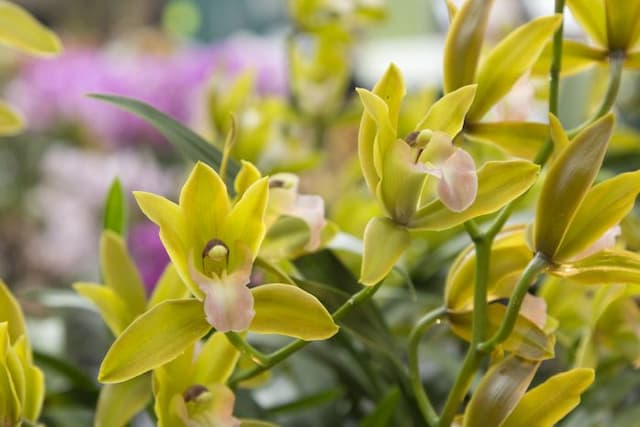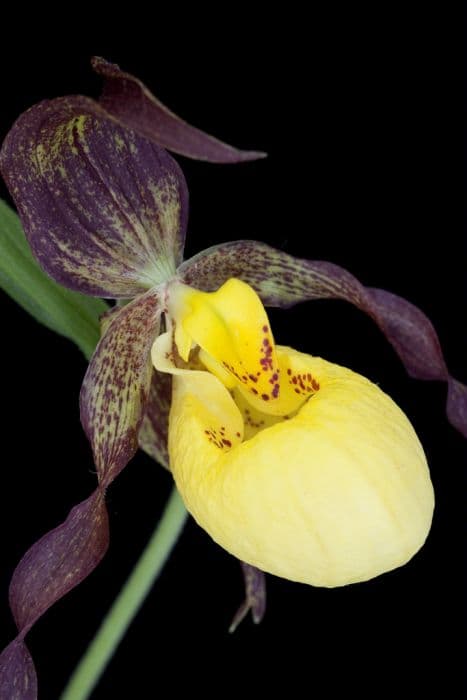Fragrant Orchid Gymnadenia conopsea

ABOUT
The plant known as the fragrant orchid displays a striking and elegant appearance. It produces a robust and leafy stem which is topped by a dense spike of intricately detailed flowers. These blooms are remarkable for their vivid pink to purplish hue, and each individual flower is marked by a delightful fragrance. The petals have a delicate, almost translucent quality, and the lip - the most prominent part of the orchid's flower - is broad with a distinctive three-lobed shape. Adding to its allure, the lip often showcases lighter coloration or patterning, which can include spots or streaks. The leaves of the fragrant orchid are lance-shaped, forming a rosette at the base, and becoming sparser as they ascend the stem. The foliage has a lush green color that serves as a beautiful backdrop to the vibrant floral display. The roots are typically concealed below the surface, but they are essential in anchoring the plant firmly to the ground. The overall impression of the fragrant orchid is one of delicate beauty and intricate design, a captivating sight that is further enhanced by its delightful scent.
About this plant
 Names
NamesFamily
Orchidaceae
Synonyms
Fragrant Orchid, Marsh Fragrant Orchid
Common names
Nigritella angustifolia, Nigritella nigra var. rubra, Orchis conopea, Orchis conopsea, Satyrium conopseum, Gymnadenia densiflora, Gymnadenia odoratissima.
 Toxicity
ToxicityTo humans
The Gymnadenia conopsea, commonly known as the Fragrant Orchid, is not considered toxic to humans. There are no well-documented cases of poisoning or noticeable symptoms resulting from ingesting this plant, and it should not pose a significant risk under normal circumstances. However, as with any plant, individual allergies or sensitivities could potentially cause reactions in some people.
To pets
The Fragrant Orchid, or Gymnadenia conopsea, is not known to be toxic to pets. There is little evidence to suggest that ingestion of this plant by animals such as dogs or cats results in poisoning. While it is not associated with toxicity, ingestion of non-food items can sometimes lead to gastrointestinal upset in pets, so it is still wise to prevent pets from consuming plants unnecessarily.
 Characteristics
CharacteristicsLife cycle
Perennials
Foliage type
Deciduous
Color of leaves
Green
Flower color
Pink
Height
1-2 feet (30-60 cm)
Spread
1 foot (30 cm)
Plant type
Herb
Hardiness zones
5
Native area
Europe
Benefits
 General Benefits
General Benefits- Aesthetic Value: Gymnadenia conopsea, commonly known as the fragrant orchid, adds beauty to gardens and natural landscapes due to its colorful and fragrant flowers.
- Wildlife Attraction: The fragrant orchid attracts a variety of pollinators, including bees, butterflies, and moths, thus supporting local ecosystems.
- Cultural Significance: This species has been celebrated in folklore and may have symbolic importance in certain regions or cultures.
- Biodiversity Support: By existing as part of diverse plant communities, Gymnadenia conopsea contributes to the overall biodiversity of its habitat.
- Education and Research: The fragrant orchid serves as a subject for botany education and scientific research, including studies on pollination and plant ecology.
- Recreation and Tourism: Beautiful orchids like Gymnadenia conopsea can be a draw for tourists and nature enthusiasts, contributing to eco-tourism and recreation industries.
 Medical Properties
Medical Properties- This plant is not used for medical purposes.
 Air-purifying Qualities
Air-purifying QualitiesThis plant is not specifically known for air purifying qualities.
 Other Uses
Other Uses- Gymnadenia conopsea, commonly known as the "Fragrant Orchid," has been used historically in perfumery due to its pleasant scent.
- The fragrant flowers of the Fragrant Orchid can be infused in oils to create scented candles and other aromatic products.
- In some cultures, the Fragrant Orchid is used in floral arrangements for special occasions, such as weddings and religious ceremonies.
- The roots of the Fragrant Orchid can sometimes be used in the production of Salep, a flour made from orchid tubers, often found in Turkish cuisine.
- Eco-friendly dyes can be obtained from the petals of the Fragrant Orchid for natural fabric dyeing processes.
- The presence of the Fragrant Orchid in its natural habitat can be an indicator species of the health of the ecosystem, particularly in meadow and grassland environments.
- Gymnadenia conopsea has been used in the craft of traditional potpourri as it retains its fragrance when dried.
- Beekeepers may place hives near populations of Fragrant Orchid to produce specialty honey with a unique flavor profile.
- The plant is occasionally used in educational settings for botanical studies due to its distinct morphological features.
- In some regions, Fragrant Orchid is collected as part of nature-related art, such as creating botanical prints or pressings.
Interesting Facts
 Feng Shui
Feng ShuiThe Fragrant Orchid is not used in Feng Shui practice.
 Zodiac Sign Compitability
Zodiac Sign CompitabilityThe Fragrant Orchid is not used in astrology practice.
 Plant Symbolism
Plant Symbolism- Fragrance: Gymnadenia conopsea, commonly known as the fragrant orchid, is renowned for its delightful scent which symbolizes allure and captivating charm.
- Rarity: As a less common sight in certain habitats, this orchid stands for uniqueness and the value of rare beauty.
- Grace and Elegance: The graceful stems and delicate blooms of the fragrant orchid embody finesse and sophistication.
- Refined Beauty: The intricate details and fine structure of the fragrant orchid's flowers suggest a meaning of detailed and understated beauty.
 Water
WaterThe Fragrant Orchid should be watered moderately during its growing season, which are the spring and summer months. Ensure the soil is slightly moist, providing about one gallon of water per week depending on temperature and humidity levels. During the winter months, reduce watering to once every two weeks, allowing the soil to dry out slightly between watering sessions. It's crucial not to overwater, as this can lead to root rot. Make adjustments to the watering frequency based on the plant's environment and the pot's drainage capabilities.
 Light
LightThe Fragrant Orchid prefers bright, indirect light conditions. It should be placed in a spot where it can receive diffused sunlight, as direct sunlight can scorch the leaves. An east or west-facing window covered with a sheer curtain is ideal for providing the soft light that this orchid needs to thrive.
 Temperature
TemperatureThe ideal temperature range for the Fragrant Orchid is between 50 and 70 degrees Fahrenheit. It can tolerate minimum temperatures down to 32 degrees Fahrenheit and maximum temperatures up to 80 degrees Fahrenheit. Keep the plant away from drafts and sudden temperature changes to maintain steady growth.
 Pruning
PruningPruning the Fragrant Orchid is not typically required for health, but spent flower stalks can be cut down to the base after blooming to maintain a tidy appearance. Pruning should be done right after the flowers have faded, which is generally after the summer blooming period. Use clean, sharp scissors or pruning shears to avoid damage and potential infection.
 Cleaning
CleaningAs needed
 Soil
SoilThe best soil mix for the Fragrant Orchid, Gymnadenia conopsea, should be well-draining and rich in humus. A mixture of loam, leaf mold, and sand or perlite works well, with a pH range of 5.5 to 7.0. Ensure the soil allows for adequate drainage to prevent water-logging, which can harm the plant.
 Repotting
RepottingThe Fragrant Orchid should generally be repotted every two to three years to refresh the soil and provide room for growth. It's best to repot the plant after flowering when new growth emerges.
 Humidity & Misting
Humidity & MistingThe Fragrant Orchid favors high humidity, ideally between 40-70%. If indoor air is dry, a humidity tray or room humidifier can help maintain these conditions, especially during winter when indoor heating can lower humidity levels.
 Suitable locations
Suitable locationsIndoor
Place in well-lit area, moderate water, maintain high humidity.
Outdoor
Plant in dappled light, rich soil, protect from harsh elements.
Hardiness zone
5-9 USDA.
 Life cycle
Life cycleThe Fragrant Orchid (Gymnadenia conopsea) starts its life as a seed, which requires a symbiotic relationship with mycorrhizal fungi to germinate successfully. Once germinated, the seedling spends its first few years developing an underground tuberoid system while aboveground growth may be minimal. As the plant matures, it produces a rosette of leaves that gather energy through photosynthesis to fuel the growth of a flowering stem. The flowering stage occurs typically between June and August when the plant blooms with spikes of densely packed pink, purple, or rarely white fragrant flowers, which are pollinated by a variety of insects, especially moths. After pollination, the flowers develop into seed capsules, containing thousands of dust-like seeds that are dispersed by the wind. This orchid can also propagate vegetatively from the tubers, ensuring its survival in the same locality for multiple seasons.
 Propogation
PropogationPropogation time
Late summer
Propogation: The Fragrant orchid is best propagated through seed sowing, which is typically undertaken in late winter to early spring when the temperature conditions are favorable for germination. Seed propagation is a complex process that involves sowing the minuscule seeds in a sterile, nutrient-rich medium. These seeds require a symbiotic relationship with specific mycorrhizal fungi to successfully germinate and develop into seedlings, a process that often occurs naturally in the wild. For cultivation purposes, specialized orchid propagation laboratories replicate these conditions to increase the chances of successful germination and growth. Once germinated, the seedlings are cared for in controlled environments until they are strong enough to be potted on or planted out. This method is challenging and generally not recommended for casual gardeners due to the precision and care required.









